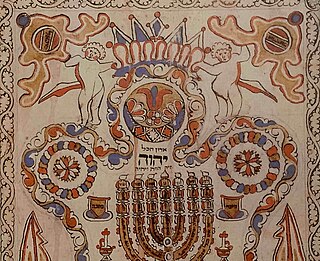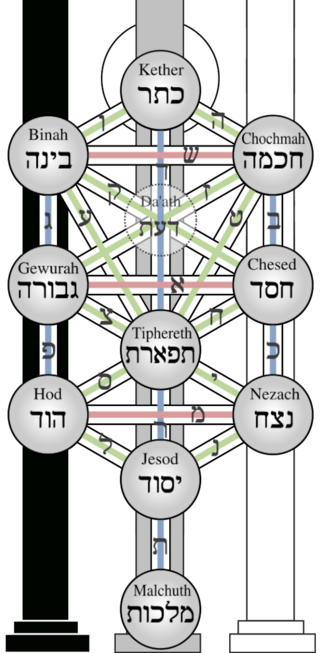
Gematria is the practice of assigning a numerical value to a name, word or phrase by reading it as a number, or sometimes by using an alphanumerical cipher. The letters of the alphabets involved have standard numerical values, but a word can yield several values if a cipher is used.

Hod is the eighth sephira of the Kabbalistic Tree of Life. It is positioned on the left side of the tree beneath Gevurah (severity) and directly opposite Netzach (eternity).
In the Zohar, Lurianic Kabbalah, and Hermetic Qabalah, the qlippoth, are the representation of evil or impure spiritual forces in Jewish mysticism, the opposites of the Sefirot. The realm of evil is called Sitra Achra in Kabbalistic texts.

Keter or Kether is the first of the ten sefirot in the Kabbalistic Tree of Life, symbolizing the divine will and the initial impulse towards creation from the Ein Sof, or infinite source. It represents pure consciousness and transcends human understanding, often referred to as "Nothing" or the "Hidden Light". Keter is associated with the divine name "Ehyeh Asher Ehyeh", meaning "I Am that I Am", which was revealed to Moses from the burning bush, and it embodies the qualities of absolute compassion and humility. Its meaning is "crown", and it is interpreted as both the "topmost" of the Sefirot and the "regal crown" thereof.
Abrahadabra is a significant word within Thelema, received and revealed by Aleister Crowley in The Book of the Law, the central sacred text of Thelema. This magical formula represents the Great Work accomplished—the union of the microcosm (individual) and the macrocosm (universe). It is considered the key to the Aeon of Horus and a word of power that symbolizes the realization of True Will.

Chokmah is the Biblical Hebrew word rendered as "wisdom" in English Bible versions. It is the second of the ten sefirot in Kabbalah, and represents the first power of conscious intellect and subtle manifestation, emerging from Keter's pure potentiality. It embodies wisdom coming from nothingness, as highlighted in the Book of Job and the Bahir. Chokmah is the primordial point of divine wisdom that becomes comprehensible through Binah.

Binah is the third sephira on the kabbalistic Tree of Life. It sits on the level below Keter, across from Chokmah and directly above Gevurah. It is usually given four paths: from Keter, Chokmah, to Gevurah and Tiphereth.

Tiferet alternatively Tifaret, Tiphareth, Tifereth or Tiphereth, is the sixth sefira in the kabbalistic Tree of Life. It has the common association of "Spirituality", "Balance", "Integration", "Beauty", "Miracles", and "Compassion".

Malkuth, Malkhut, Malkhuth, or Malchus, is the tenth of the sefirot in the Kabbalistic Tree of Life.
Sathariel is described in the Book of Enoch as the 17th Watcher of the 20 leaders of the 200 fallen angels. Michael Knibb believes the name to mean "Moon of God" or "Dawn of God" based on the Ge'ez copies of the Book of Enoch.

The Mathers table of Hebrew and "Chaldee" (Aramaic) letters is a tabular display of the pronunciation, appearance, numerical values, transliteration, names, and symbolism of the twenty-two letters of the Hebrew alphabet appearing in The Kabbalah Unveiled, S.L. MacGregor Mathers' late 19th century English translation of Kabbala Denudata, itself a Latin translation by Christian Knorr von Rosenroth of the Zohar, a primary Kabbalistic text.

The tree of life is a diagram used in Rabbinical Judaism in kabbalah and other mystical traditions derived from it. It is usually referred to as the "kabbalistic tree of life" to distinguish it from the tree of life that appears alongside the tree of the knowledge of good and evil in the Genesis creation narrative and well as the archetypal tree of life found in many cultures.
In Thelema, the Abyss represents a metaphysical concept that signifies the great chasm or void separating the manifest world from its divine source. Aleister Crowley, the founder of Thelema, extensively explored and integrated this concept into his esoteric teachings, imbuing it with deep spiritual significance.
Within Thelema, the Great Work is the spiritual endeavor aimed at realizing one's True Will and achieving a profound mystical union with Nuit, the Thelemic personification of the infinite and boundless expanse of the universe. This path, crafted by Aleister Crowley, draws inspiration from Hermetic alchemy and the Hermetic Qabalah. The cornerstone of Thelema is the Book of the Law, received by Crowley in 1904 through a communication with the entity Aiwass. This text became the central scripture, heralding a new Aeon for humanity and outlining the principles of Thelema.

In ceremonial magic, a magical formula or a word of power is a word that is believed to have specific supernatural effects. They are words whose meaning illustrates principles and degrees of understanding that are often difficult to relay using other forms of speech or writing. It is a concise means to communicate very abstract information through the medium of a word or phrase.
George Cecil Jones, Jr., was an English chemist, occultist, one time member of the Hermetic Order of the Golden Dawn and co-founder of the magical order A∴A∴. According to author and occultist Aleister Crowley, Jones lived for some time in Basingstoke, Hampshire, England, working at a metallurgy there.
IPSOS, meaning "themselves", is the magical formula of the Aeon of Ma'at as transmitted by Nema Andahadna in her inspired magical work, Liber Pennae Praenumbra. It is used by the Horus-Maat Lodge and Kenneth Grant's Typhonian Order. According to Kenneth Grant, its initiated translation is "the same mouth".

Hermetic Qabalah is a Western esoteric tradition involving mysticism and the occult. It is the underlying philosophy and framework for magical societies such as the Hermetic Order of the Golden Dawn, has inspired esoteric Masonic organizations such as the Societas Rosicruciana in Anglia, is a key element within the Thelemic orders, and is important to mystical-religious societies such as the Builders of the Adytum and the Fellowship of the Rosy Cross.

Chesed is one of the ten sefirot on the kabbalistic Tree of Life. It is given the association of kindness and love, and is the first of the emotive attributes of the sephirot.
Therion (thēríon) is a deity found in the mystical system of Thelema, which was established in 1904 with Aleister Crowley's writing of The Book of the Law. Therion's female counterpart is Babalon, another Thelemic deity. Therion, as a Thelemic godform, evolved from that of "The Beast" from the Book of Revelation, whom Crowley identified himself with since childhood, because his mother called him that name. Indeed, throughout his life he occasionally referred to himself as “Master Therion” or sometimes “The Beast 666”. He wrote:
Before I touched my teens, I was already aware that I was THE BEAST whose number is 666. I did not understand in the least what that implied; it was a passionately ecstatic sense of identity.







